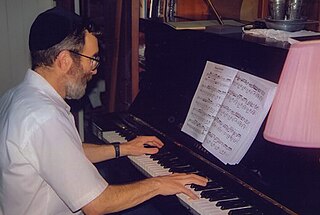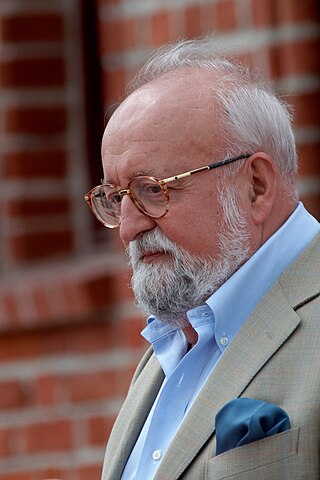Related Research Articles
A piano sextet is a composition for piano and five other musical instruments, or a group of six musicians who perform such works. There is no standard grouping of instruments with that name, and compared to the string quartet or piano quintet literature, relatively few such compositions exist. The best-known piano sextet is probably the Sextet by Poulenc, one of the pinnacles of the wind and piano repertoire. Chausson's Concert is widely regarded as one of the masterpieces of French strings and piano chamber music literature.

Paul Schoenfield, also spelt Paul Schoenfeld or Pinchas Schoenfeld, was a classical composer and pianist known for combining popular, folk, and classical music forms. He was born in Detroit, Michigan and died in Jerusalem, Israel.
Tristan Keuris was a Dutch composer.
Felix Mendelssohn's Sextet in D major, Op. 110, MWV Q 16, for piano, violin, two violas, cello, and double bass was composed in April–May 1824, when Mendelssohn was only 15, the same time he was working on a comic opera Die Hochzeit des Camacho. Its composition took place between the Viola Sonata and the Piano Quartet No. 3. It also preceded the famous Octet, Op. 20 by about a year. 1824 is also the probable year of the composition of the Clarinet Sonata. Like the latter, the Sextet was not published during the composer's lifetime. Its first edition was issued in 1868 as a part of a complete collection of Mendelssohn's works, hence the misleadingly high opus number.
Rafał Stradomski is a Polish composer of contemporary classical music, pianist and writer.
Füsun Köksal is a Turkish composer of contemporary classical music.

Marek Stachowski was a Polish composer. He received many awards and won many competitions for composers, including first prize at the K. Szymanowski Competition in 1974.
Jeajoon Ryu is a South Korean composer. His works have been by performed some of the world’s leading orchestras, such as the Royal Philharmonic Orchestra (RPO), l'Orchestre régional de Cannes-Provence-Alpes-Côte d’Azur (ORCPACA), the Helsinki Philharmonic Orchestra, and the Polish Radio Symphony Orchestra. He was the artistic director of Seoul International Music Festival from 2009-2010 and a composer of Poland Gozow Philharmonic Orchestra from 2011-2012. Artists such as Arto Noras, Michel Lethiec, Ralf Gothoni, Li-Wei Qin, Shanghai Quartet, Juyung Baek, So-Ock Kim, Johannes Moser and Ilya Gringolts have performed his works.
The Sextet is a two-movement composition for clarinet, horn, violin, viola, cello, and piano by Polish composer Krzysztof Penderecki. The composition was written in 2000 and is, according to some critics, the composer's most substantial chamber work.

The Suite is a composition for solo cello by Polish composer Krzysztof Penderecki. The piece is well known for its typical chromatic melodies and for its recurrent use of pizzicati and col legno.
The Partita for Harpsichord and Orchestra, sometimes also referred to as Partita for Harpsichord, Electric Guitar, Bass Guitar, Harp, Double Bass, and Chamber Orchestra or Harpsichord Concerto, is a composition by Polish composer Krzysztof Penderecki. It was finished in 1971 and is Penderecki's only major composition for a harpsichord soloist.

The Symphony No. 1 by Polish composer Krzysztof Penderecki was composed in 1973. It was published by Polish Music Publishing House and Schott Music and has never been expanded or revised.

The Dream of Jacob, also referred to as The Awakening of Jacob, is a composition by Polish composer Krzysztof Penderecki. It is scored for large orchestra and was finished in 1974.
The Capriccio for Violin and Orchestra is a composition by Polish composer Krzysztof Penderecki. It is one of the five caprices that he composed and one of the two that he composed for a soloist with an orchestra, together with the Capriccio for Oboe and Eleven Instruments.
Emanations, also referred to by its original German title Emanationen or by its Polish title Emanacje, is a composition for two orchestras by Polish composer Krzysztof Penderecki. Composed in 1958, it is one of his early compositions.
The Prelude for Clarinet in B-flat major, sometimes also referred to as Prelude for Solo Clarinet, is a work by Polish composer Krzysztof Penderecki. It was composed in 1987 and is one of the pieces from the series of compositions for solo instruments that Penderecki composed during the 1980s, such as Cadenza for Solo Viola (1984) and Per Slava (1986).
The Clarinet Quartet, also known as Quartet for Clarinet and String Trio, is a work for clarinet, violin, viola, and cello by Polish composer Krzysztof Penderecki. It was finished in 1993.

Jean-Marc Fessard is a French classical clarinetist.
Barbara Jazwinski is a Polish-American composer and pianist known for her contributions to contemporary music. She is Head of the Composition Program at the Newcomb Music Department, Tulane University in New Orleans. She was honored with the Prince Pierre of Monaco Composition Award for her work on the Sextet, and she also secured the top position in the Nicola De Lorenzo Composition Contest for her composition of Music for Chamber Orchestra.
References
- ↑ "3 miniature".
- ↑ "Blue" Gene Tyranny. "Krzysztof Penderecki Miniatures (3) for clarinet & piano". Rovi Corporation. Retrieved 23 February 2014.
- 1 2 3 4 5 6 7 8 9 10 11 12 Bylander, Cindy (2004). Krzysztof Penderecki : a bio-bibliography. Westport: Greenwood Publishing Group, Inc. ISBN 0-313-25658-6.
- 1 2 "Three Miniatures for clarinet and piano". Nadorowy Instytut Audiowizualny. Retrieved 23 February 2014.
- ↑ Whitehouse, Richard. "About this Recording 8.557052 – PENDERECKI: Sextet / Clarinet Quartet / Cello Divertimento". Naxos Digital Services. Retrieved 23 February 2014.
- ↑ "Three Miniatures composer: Krzysztof Penderecki". Schott Music. Retrieved 23 February 2014.
- ↑ McDermott, Vincent (1968). "Milwaukee". Musical Quarterly. 54 (4): 524. doi:10.1093/mq/LIV.4.524.
- ↑ "The Virtuoso Clarinet". BIS Records AB. Retrieved 23 February 2014.
- ↑ "CD332: Clarinet Candescence. Melvin Warner, Clarinet". Crystal Records. Retrieved 23 February 2014.
- ↑ "MEYER, SABINE 20th Century Classics: Penderecki". Warner Classics. 9 January 2012. Retrieved 23 February 2014.
- ↑ "Musica da camera". WERGO. Retrieved 23 February 2014.
- ↑ "PENDERECKI: Sextet / Clarinet Quartet / Cello Divertimento". Naxos Digital Services. Retrieved 23 February 2014.